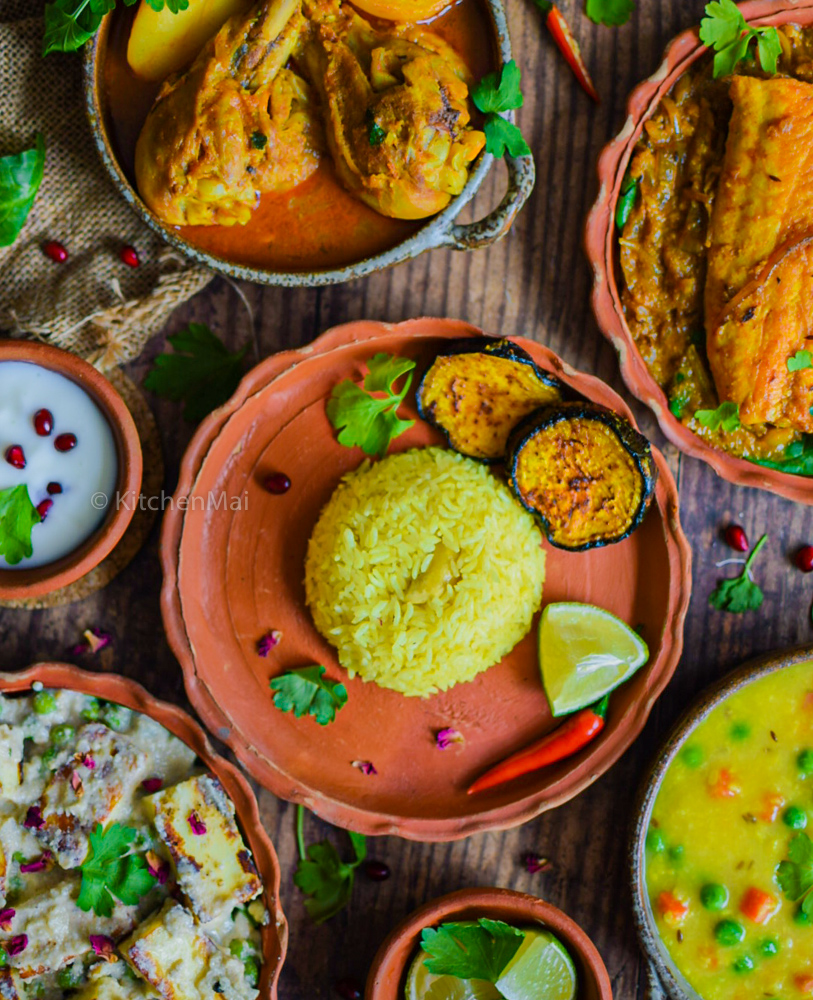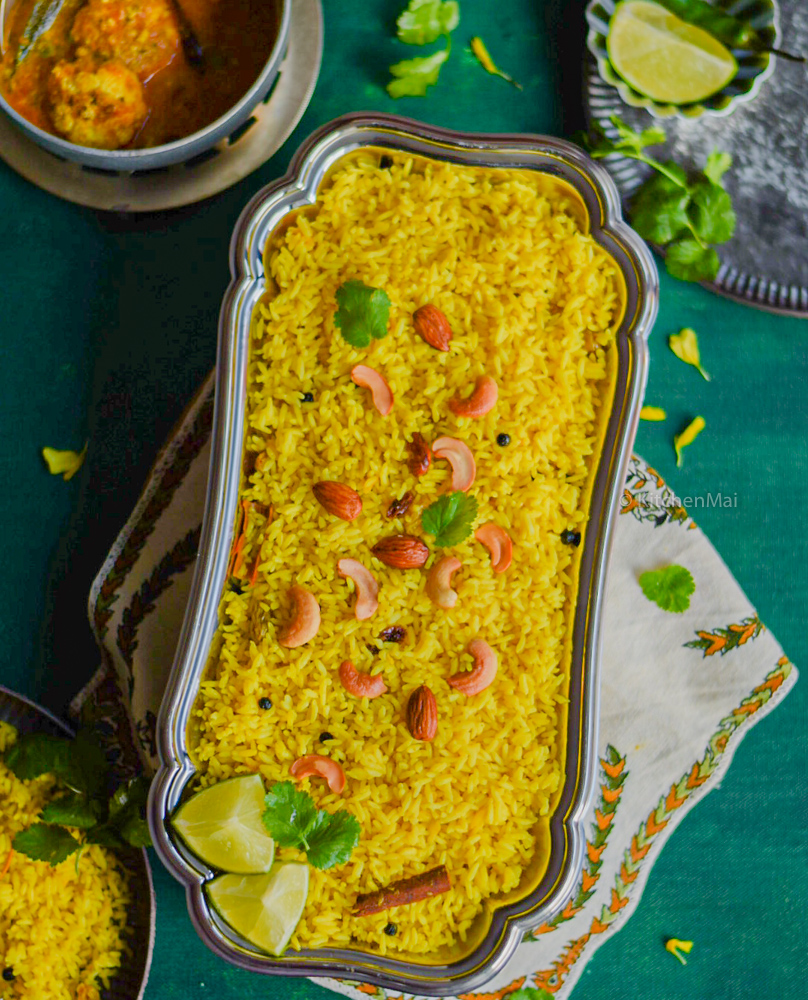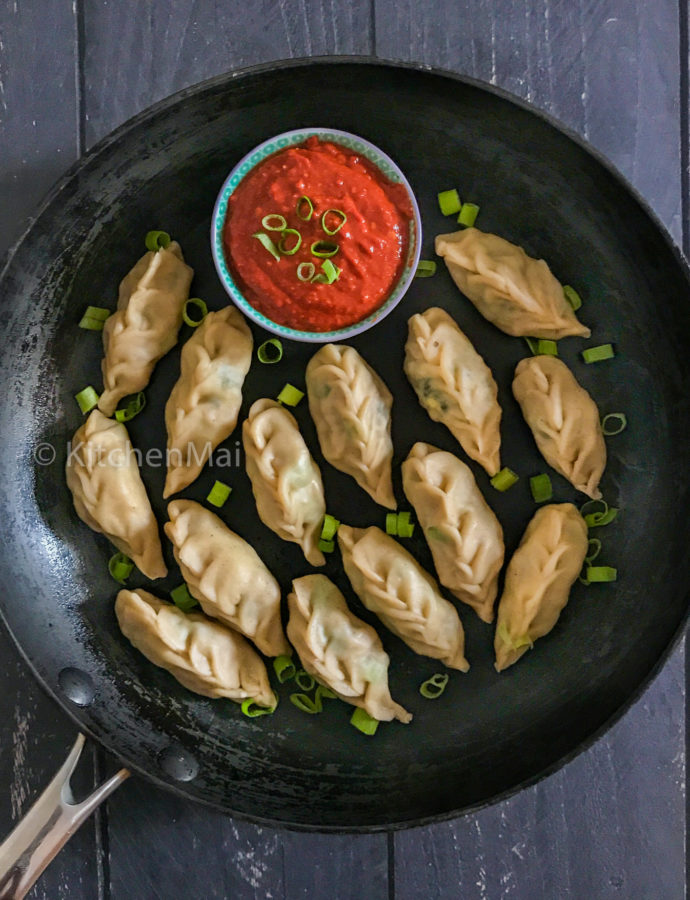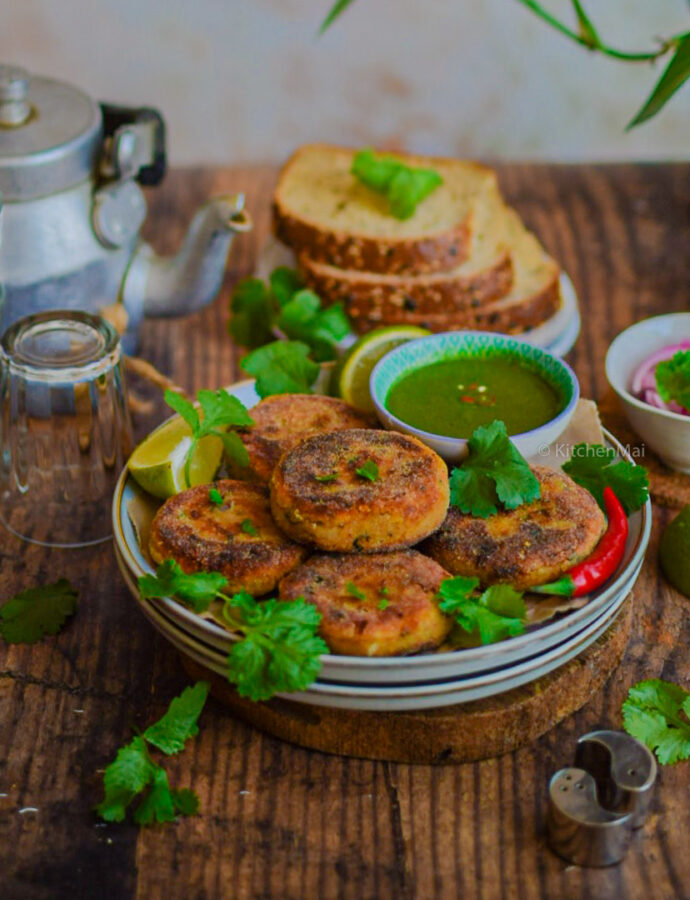This traditional, Bengali bright yellow (basanti) colored, sweet rice recipe is made in ghee, whole spices and assorted nuts. Generally made for special occasions and festivals, this is ‘the’ pulao in Bengali cuisine
Maa always makes this beautiful, fragrant and delicious basanti pulao on special occasions. For instance, Bengali new year (poila boishakh), birthdays, nabami lunch, are some definite days on which she makes this. Likewise, even this year it is on our new year (15th April 2021) lunch menu. While I have never made it, even though we love it, I decided to cook the Bengali basanti pulao this time. Therfore, we too are celebrating the new year with delicious Bengali food, including the very special pulao. Now, for those of you who make not know, the color yellow is called basanti in Bengali, hence the name of this recipe. Alternatively, it is also called mishti pulao, because, this yellow rice is pre-dominantly sweet to taste. While you can definitely adjust the sweetness as per taste, it has got to be more sweet that savory.
However, you may simply call it pulao – without pre-fixing it with basanti or mishti. That’s because, the quintessential Bengali pulao is this. This amazing rice recipe is made in ghee, fragrant whole spices and loaded with nuts. And it’s signature yellow color comes from turmeric powder. While most recipes of this pulao are niramish, that is made without onion or garlic, mine isn’t. The method that I follow, even maa does is of my pishimoni’s. My paternal aunt, pishimoni, makes the best pulao in the family and all of us swear by her recipe. And her secret is the use of onion-ginger-garlic paste. Of the three, the onion and garlic are added in small quantities as opposed to the ginger. Even though in lesser quantities, their scents make the pulao taste heavenly.
You may also like,
Sweet corn and peas pulao (pilaf)
Bengali basanti pulao
Having said that, if you prefer your pulao to be niramish you can very well leave the onion and garlic out of the recipe. Simply follow the same recipe leaving these two aside. In fact, when we make the mishti pulao on a pujo day we do the same. I promise you, it will still taste yum. Nonetheless, once you’ve made it with the onion and garlic pastes, you won’t go back to the one made without it. 😉
Now the most important bit, what kind of rice should you be using here? Traditionally, the mishti pulao is made with gobindobhaog chaal, which is grown in West Bengal. This is a non-sticky, very fragrant, short grain variety of rice widely used in Bengali cooking. Our pulaos and even khichdis are made with it. This variety is easily available in India and I have been able to find it even in London. However, if you aren’t able to get hold of this one, you could use any short grain, non-sticky variety of rice. The South Indian rice variety seeraga samba, is actually a wonderful substitute. If you can find even this one, use it to make your Bengali pulao.
Serving suggestions
Since this is a mishti pulao, you could pair it with spicy curries. While macher kalia and mutton curry are more popular choices, even bhaja moong dal and paneer pair very well with it. In fact, on our lunch menu this new year, we have the Bengali basanti pulao with chicken curry, fish kalia, moong dal, paneer rezala and begun bhaja. And to cool the palette down, there also is some chilled yoghurt topped with pomegranate arils. In fact, this ghee laden and aromatic pulao tastes so good that I can have it just as it, as well.
Whether you have the pulao with a spicy curry or a dal or just so, you will throughly enjoy it. This Bengali basanti pulao is truly a gem of a recipe and it is sure to win you praises from your loved ones. Also, it tastes even better the next day so you could always make it in advance when planning to make it for an occasion. Whether for a special occasion or simply for the weekend, if you are planning to make this deliciousness, I’d love hearing back from you. You could share your food pictures with me over on Instagram, if you wish to. On the other hand, you could even share your feedback in the comments section below.
Eat hearty!
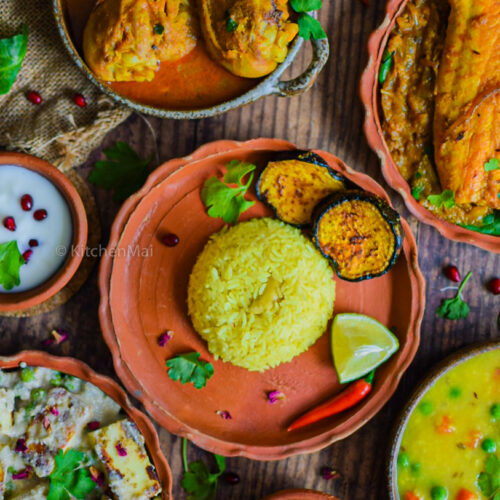

Bengali basanti pulao (mishti pulao)
Equipment
- Shallow cooking pot with lid
Ingredients
- 250 g Gobindobhog rice or any short grain non sticky rice
- 80 g sugar
- 1 tbsp onion paste
- 1 tbsp ginger paste
- ½ tbsp garlic paste
- 2-3 fresh chilis slit
- 1½ inch cinnamon stick
- 3-4 green cardamoms
- 3-4 cloves
- 2 bay leaves
- 1 tbsp black peppercorns
- 1 blade mace
- 1 tbsp turmeric powder
- 1 tsp salt
- 8-10 cashews
- 8-10 almonds roughly chopped
- 10-12 raisins
- 4-5 tbsp ghee
Instructions
- Wash the rice 3-4 times throughly with water. Keep it soaked for 10 minutes
- In your cooking pot, add the ghee and let it melt. Add the whole spices (except the mace) and once they turn aromatic, add the onion, ginger and garlic pastes
- Fry over medium flame, until the raw smell of the pastes go away. Be careful to not let them brown, otherwise your pulao will not remain yellow
- Drain the rice and add it to the cooking pot, mix well, coating each grain with the ghee, whole spices and onion mixture. Pour 500g of water and stir gently
- Add the salt, sugar, turmeric, mace, chilis, cashews, almonds, raisins and mix gently. Turn the flame to medium high and cook until the water on the surface of the rice evaporates. Thereafter, lower the heat to minimum, cover and cook for 7 minutes
- Remove from heat and let it sit covered for another 7-10 minutes. Serve your amazing Bengali basanti pulao with a curry or dal of choice and enjoy!

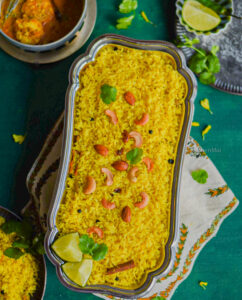
Notes
- The color of your basanti pulao has to be lemon yellow and not dark yellow, so adjust the amount of turmeric powder to be added accordingly
- Even jeeraga samba rice variety works well in this recipe
- If you want to keep the onion and garlic pastes out, follow the same recipe and omit them
- Always add the sugar after you've added the water, otherwise, it could caramelize and make the rice turn brown which is undesirable
- You may also fry the nuts and add them to the pulao
- g - grams
- tsp - teaspoon
- tbsp - tablespoon

